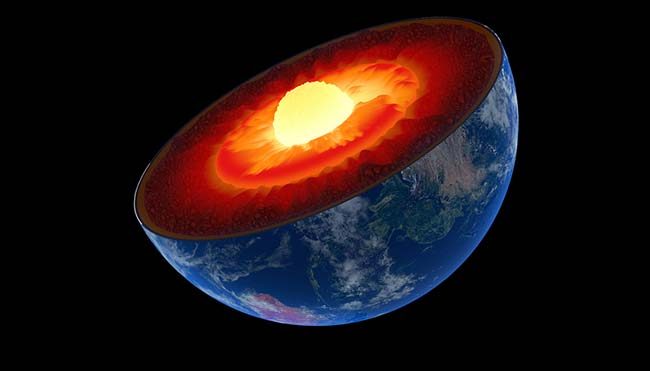A recent study suggests that the Earth’s inner core has a resemblance to a ball of butter rather than a solid metal sphere.
Recent studies have brought into question the long-held belief about the solidity of Earth’s inner core, which has traditionally been compared to a solid metal sphere.
According to Youjun Zhang, a key researcher from Sichuan University, the Earth’s core might actually have a more viscous texture than previously thought, likened to the softness of butter in a kitchen environment, as detailed in a statement from the University of Texas.
These new discoveries have the potential to provide insights into longstanding mysteries surrounding our planet, including the ongoing puzzle of Earth’s erratic magnetic field.
Given that direct observation of the Earth’s core is currently unattainable due to technological limitations, scientists rely on seismic wave data from earthquakes to gain knowledge about the planet’s internal structure.
By studying how these waves interact with different layers within the Earth, researchers can draw conclusions about its internal processes.
Previous scientific models had suggested that the intense pressure at the Earth’s core would cause iron atoms to form a solid structure, despite the extreme temperatures.
These models portrayed the iron atoms arranged in a hexagonal pattern, indicating the presence of a solid metal core (the inner core) surrounded by liquid metal (the outer core).
However, recent research has shown that this depiction may not be entirely accurate.
Revealing the Inner Composition of the Earth
In 2021, a study was initiated to challenge the long-held belief that the Earth’s core is a solid iron sphere. Researchers observed seismic wave behaviors that did not align with this notion, suggesting a more intricate inner structure.
Jessica Irving, a seismologist from the University of Bristol, shared her insights with Live Science, shedding light on the evolving understanding of the composition of the Earth’s core.
Recently, a groundbreaking study published in the peer-reviewed journal Proceedings of the National Academy of Sciences aimed to unravel this mystery. By conducting advanced laboratory simulations that replicated the extreme pressure and temperature conditions found in the Earth’s core, along with sophisticated computer models, researchers embarked on deciphering this enigma.
The investigation yielded a fascinating revelation: the atoms within the core arrange themselves in a hexagonal pattern. However, contrary to expectations, individual iron atoms exhibit mobility within this structure, similar to guests shifting positions around a dinner table, as explained in the press release.
Zhang, a key contributor to the study, emphasized the remarkable discovery that solid iron demonstrates unexpected softness deep within the Earth due to the significant atomic mobility.
Understanding the dynamics of the Earth’s interior holds great significance beyond mere scientific curiosity. It plays a crucial role in unraveling the complexities of the Earth’s magnetic field, which acts as a shield, protecting our planet from cosmic radiation and stabilizing the atmosphere.
The conventional representation of the magnetic field as concentric rings resembling layers of an onion does not accurately reflect its true complexity. In reality, the magnetic field is characterized by dynamic behavior, experiencing shifts, occasional reversals, and unexplained irregularities.
Understanding the behavior of the Earth’s inner core is crucial in unraveling the mysteries of the magnetic field, as it is the source of the Earth’s magnetic field through the movement of molten metal within it.
Jung-Fu Lin, a professor at the UT Jackson School of Geosciences and the lead author of the study, highlighted the importance of this discovery in shedding light on the fundamental mechanisms that drive the dynamic processes and evolution of the Earth’s inner core.
Do not forget to share your opinion with us to provide you with the best posts !




0 Comments